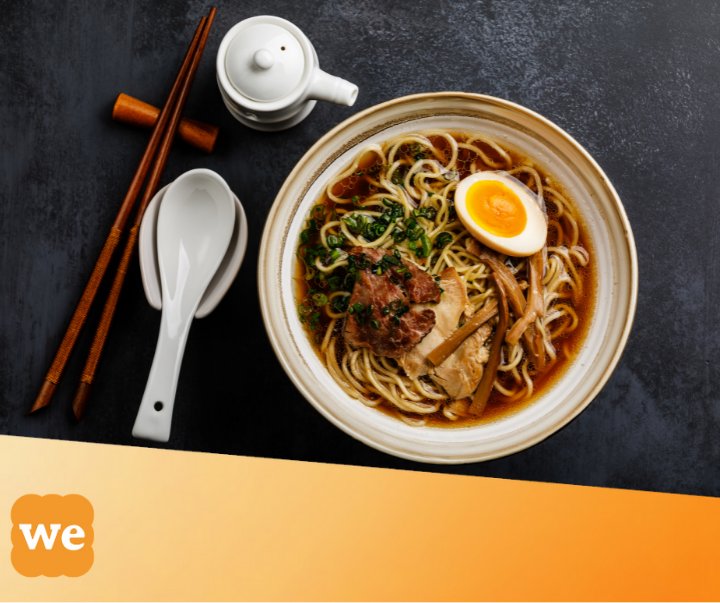
Ramen (ラーメン ) is one of the most famous and important dishes in Japanese cuisine. It consists of wheat noodles served in a pork bone, chicken, or fish-based broth. Sliced roast pork (チャーシュー/chāshū), nori (seaweed), boiled egg, and negi (scallion) are added to the soup. A complete and nutritious Japanese dish.
Continue to read this article to find out the history of ramen noodles, and some curiosities about this delicious food!
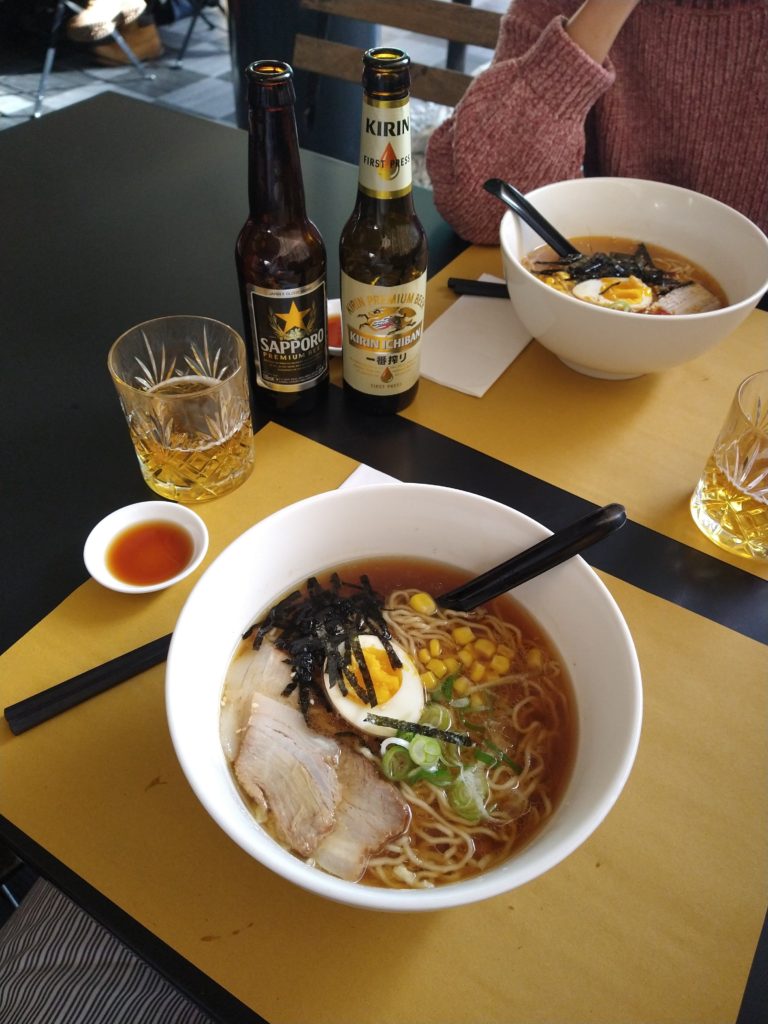
Shōyu ramen, a classic type of ramen
Every region in Japan has its own variety of ramen, based on its climatic and environmental aspects. You can find a ラーメン屋 (ramenya = ramen restaurant) in almost every corner of a Japanese town. There are even ramen stands in smaller ones.
Ramen ya is not a big restaurant but small and with a cozy atmosphere. Once in Japan, sit there for a few minutes, make your order, and taste your Japanese specialty!
What's the Origin Of ラーメン?
The origin of ramen is not clear. Most certainly it's a Japanese adaptation of Chinese wheat noodles, introduced in the late 19th century. The word ラーメン itself is written in katakana, meaning it was borrowed from a foreign language. Chinese restaurants began to line the streets of Japan’s major port towns. After that, Japanese locals began to set up their own independent carts (屋台 - yatai) on the streets. This is probably when ramen soup became different from the Chinese version, making the Japanese one more specialized and adapted to the noodles’ flavor.
The word “ramen” has a controversial origin, with various theories:
- One says it is the Japanese transcription of the Chinese la mian (拉麺), a type of soft wheat flour Chinese noodle.
- Another theory attributed to the Chinese word lo mein (撈麵), which means to mix, referring to noodles mixed with the soup.
Introduction of Ramen in Japan
Certainly, during the Shōwa period (1926 to 1989) ramen became very popular in Japan among people who preferred to have dinner outside their homes. Back in that time, eating ramen was a special occasion, a moment to distract from the daily routine.
The first ramen restaurant was founded in Yokohama in 1910, and some years later the world’s first instant ramen was invented. Its distribution and popularity spread, allowing many people to cook noodles at home, simply by adding some hot water. The convenience and rapidity of this process have remained unchanged, and thanks to that ramen became very popular even overseas. Then, in 1994, the Shin-Yokohama Museum was founded, attesting to its first origin. There you can taste the most famous varieties of ramen and see and experience the traditional technique for making noodles.
Nowadays, people not living in Japan or oriental countries may think that ラーメン is only instant ramen, due to its extraordinary distribution overseas. (Just think that you can buy instant noodles even on Amazon!) However, they do not know how it is hard to prepare good broth and hand-made noodles for it.
Ramen Flavors: What Can You Find In It
In Japan, you can taste ramen in a ramen ya, literally “ramen store”. (Adding -屋 や to a goods word creates the relative “shop/store” for that word; try it with other words: udon ya うどん屋, hon ya 本屋 bookshop, kutsu ya 靴屋 shoes store.)
Here you can choose between Miso (味噌 - みそ a soybean paste), Shōyu (醬油 soy sauce), or shio (塩 salt) ramen. This refers to what flavor is added to the soup (出し dashi). Additional variations include a vegan version or a spicy Miso, the latter of which can be customized with different levels of spiciness or by adding karee (カレー curry) to the ramen.
Ramen noodles are prepared with 4 ingredients: wheat flour, salt, water, and kansui (かん水 - かんすい). Kansui is an alkaline solution that originates in Mongolia which adds to ramen its unique flavor characteristics. Eggs can be used as an alternative.
In a ramen ya menu, you will also find 餃子 (ぎょうざ - gyōza). This is a Chinese dumpling that can be boiled, steamed, or pan-fried and is filled with meat or chopped vegetables. The Japanese version is usually the pan-fried one and may be served with soy sauce, wasabi, karashi (mustard), or other condiments.
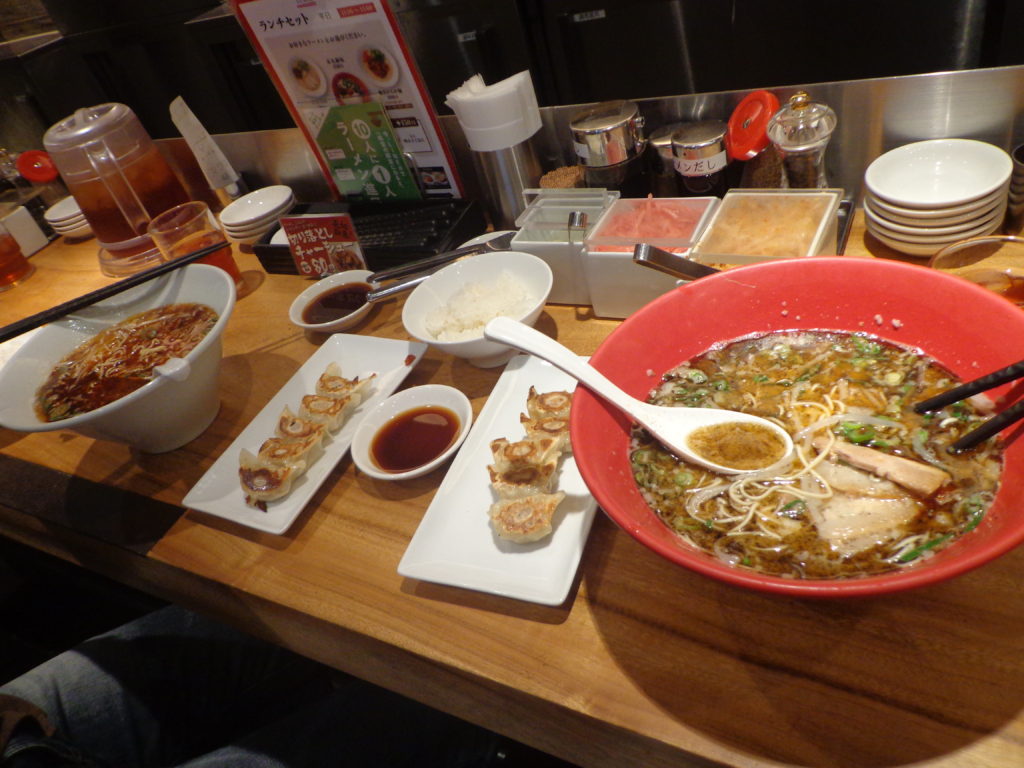
Japanese cuisine: a typical set of ramen and gyōza in a ramen-ya. A little bowl of rice is always added for free!
The Most Famous Types Of Japanese Ramen
As previously mentioned, there are different varieties of ramen for almost every region of the country. Here are the most famous ones:
- In Kyōto, there is Assari-Kei ramen. More soy sauce is added to the broth, and roasted pork and white pepper are added as toppings.
- In the city of Nagoya, it seems that a famous Taiwanese chef invented a particular type of ramen where minced meat, scallion, chili pepper, and garlic are added. He dedicated this variety to his homeland, and called it simply “Taiwan ramen.”
- The Shikoku region is popular for producing pork belly meat to add to its ramen to give it a stronger taste.
- In Fukuoka City, Hakata ramen uses pork bones that are cooked for three days before adding them to the broth. Sesame, mustard, and ginger can be added to further enhance its taste.
- In Kumamoto City, on Kyūshū island, you can find a recipe created in 1954. Here, a mild-flavored sauce is combined with a chicken bone and vegetable broth over a tonkotsu (pork bone) base. The soup includes its own specially-flavored oil, with roasted, crumbled garlic chips scattered on top. Sapporo, the capital of the Hokkaido region, is well known as the miso ramen homeland. In the city, there is an entire street dedicated to ramen restaurants. Butter, soybeans, and corn are added.
Japanese Noodles: Various Types of Them
In Japan as in China or Korea, noodles exist in a variety of types, and ramen is surely the most famous one in the world.
In general, you can call Japanese noodles men, written with the character 麵 - めん. But do not think about a "man", due to its pronunciation!). The kanji alone means “flour” but to say flour the term mugiko 麦粉 - むぎこ is used.
The ramen type of men is thin and often curly, wheat-based, and yellow in color. They are sometimes called ちゅうかそば (中華そば in kanji), chūka soba, meaning “Chinese soba”.
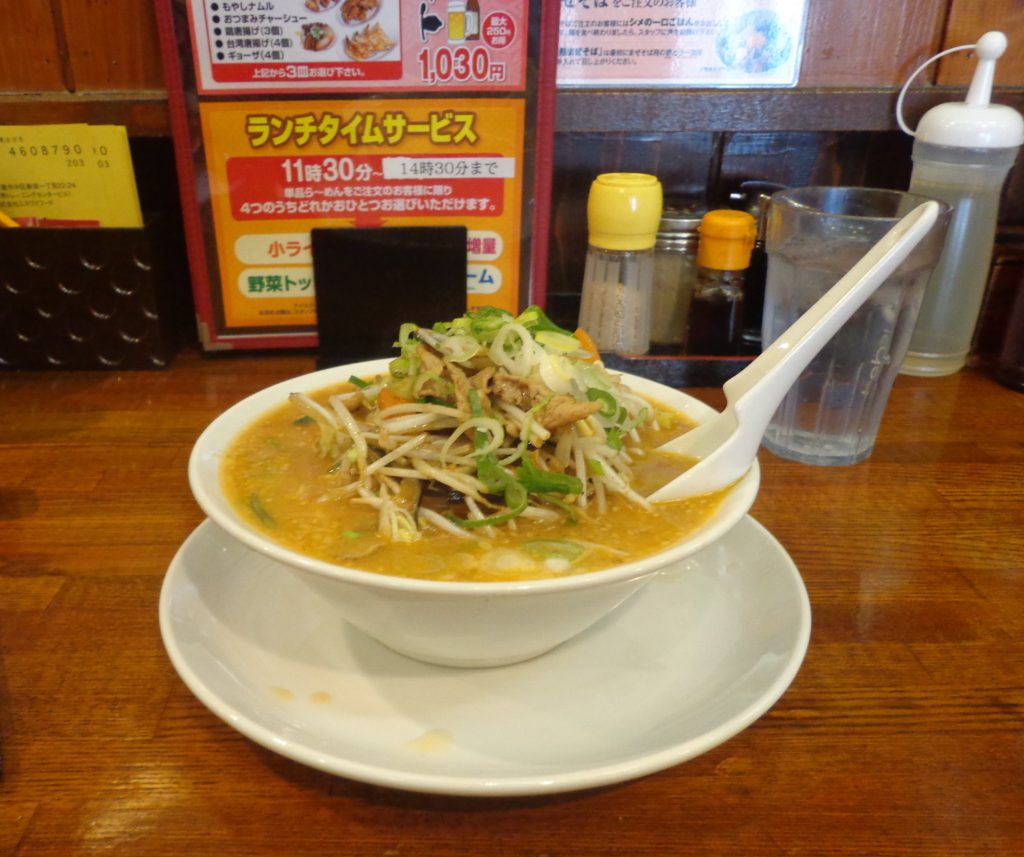
Soba
Soba is another type of noodles: they are made with a mixture of buckwheat and wheat flour. They can be served in a soup like ramen, or chilled and put on a bamboo tray with nori seaweed and green onions, ready to be eaten only by adding tsuyu (つゆ). This is the “lighter” version of the soy sauce, with kombu seaweed and dried tuna, usually added to tempura (deep-fried seafood or vegetables).
Soba is commonly known as the “dietetic” version of men because it contains poor calories. On New Year’s Eve in Japan, you can taste the toshi koshi soba (年越しそば – としこしそば), where the noodles will be longer than usual to wish a long life to everyone who eats them. It will bring bad luck to cut the noodles with your teeth, so be careful!
About soba, there is another dish name that is very popular: Yakisoba 焼きそば (やきそば). Yaki - 焼き comes from the verb 焼く, which means “to bake, to grill.” Yakisoba is prepared by frying ramen noodles (not the soba ones!) together with chopped vegetables and bite-sized pork on a big electric stovetop. It is very simple to do at home, just add the yakisoba sauce, salt, and pepper.
Udon
Udon (うどん) is the thickest type of noodles made from wheat flour and white in color. They are boiled in a pot of hot water and served, like soba, chilled in the summer and hot in the winter. One of the most famous types is the kitsune udon, where きつね means “fox” because in this kind of うどん you will taste the aburaage (あぶらあげ - 油揚げ sweet, deep-fried tofu pouches), considered foxes’ favorite food!
When the noodles are served cold and separated from the hot soup, the ramen, soba, or udon dish is called Tsukemen - つけ麵. You will have to dip your men in the soup, and then add the condiments you prefer, which are eggs, nori, chashu, and negi. It is very common to eat つけめん during summertime. This dish was invented in 1961 in Tōkyō and now it is very popular in the United States.
Ramen in anime
Ramen is everywhere in anime! As a traditional and popular Japanese food, you can find it in a variety of anime.
Famously, Masashi Kishimoto, the author of Naruto, admitted in an interview that he really loves ramen and used to eat it in a ramen ya near the University where he studied. There, he befriended the cook and so decided to recreate the same atmosphere in his comic. In fact, in the anime, you can often see the protagonist eating in a ramen ya. The name of the protagonist himself is a tribute to one of the ingredients you can add to ramen. なると - Naruto is in fact the steamed fish paste, usually white and pink colored, which is added to the Ichiraku Ramen in the story. It is also called かまぼこ - 蒲鉾 - kamaboko.
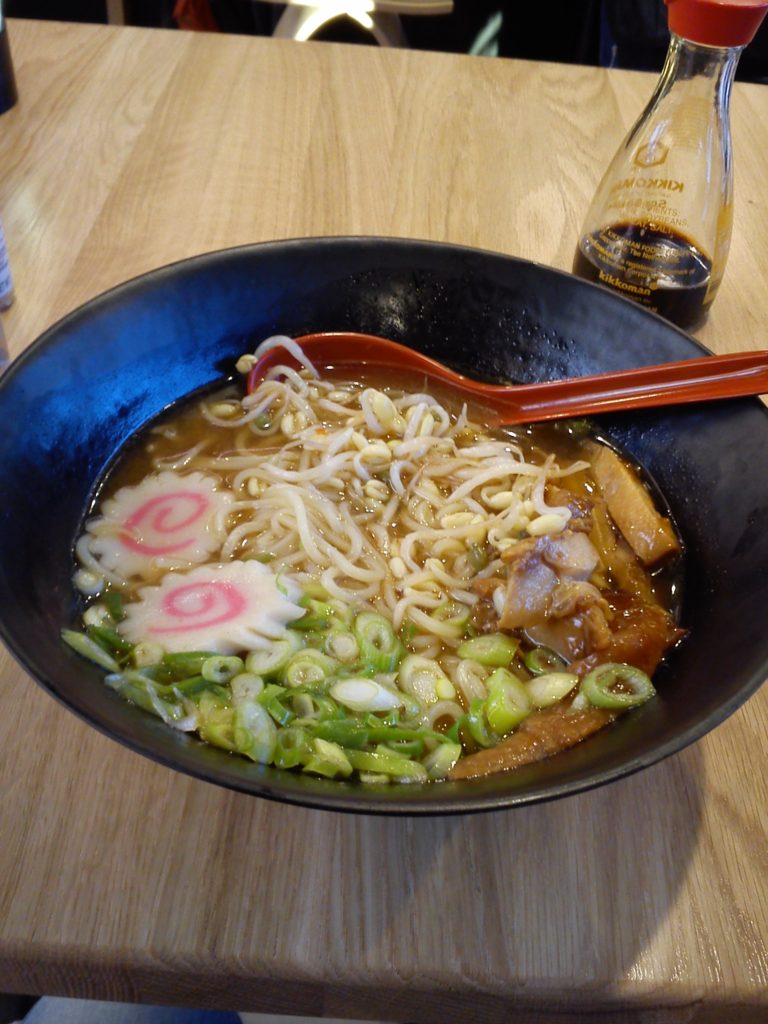
A typical Shōyu ramen with Naruto!
Table etiquette phrases
The phrases you will usually hear, in the anime as in real-life ramen ya, would be いただきます (itadakimasu), which is said every time before enjoying a meal. Be careful not to say this one to someone else because it is used only for one’s self; to wish someone else a good meal you can say “召し上がれ” (meshi agare), where めし has the meaning of “meal.” If you find your ramen even better than you imagined, you can say おかわり! (okawari) to refill your bowl and get another portion.
Demon Slayer - Kimetsu no yaiba
In the anime 鬼滅の刃 kimetsu no yaiba too, we can find the protagonist Tanjiro and his sister Nezuko wandering in the capital and then finding an empty street where they see a little udon shop. Here the protagonist will order a 山かけうどん ( Yamakake Udon). It's a simple version of udon where tuna and tororo, a sticky food made from grating a yam, are added. Tanjuro is ordering it by saying “やまかけうどんください。” (Yamakake udon kudasai). When making an order, just adding ください to what you want is sufficient. After, you can hear the cook say, “山かけうどん一丁出来上がり!” (Yamakake udon iccho dekiagari). Here, 一丁 いっちょう refers to a single portion of Udon, and this is a way to count portions only used by cooks or waiters. Lastly, できあがり means that something is ready in any concrete context and not limited only to cooking.
One Piece
Of course, this dish also compares in One Piece: in the recent Wano saga, the crew’s cook Sanji, opens a traditional やたい to sell his version of ramen. Here he will do a pun on his name, naming the stand 十八番そば (ohako soba): his name is Sangoro in this time frame, so さん (three) + ご (five) ろ, and the dish he is serving is called 二八そば (nihachi soba), a type of soba containing 20% wheat and 80% buckwheat, composed by numbers 2 and 8. To explain it, he says さんごろのにはちそばしめて。。。18番!(Sangoro no Nihachisoba shimete...jūhachiban!) and so 3+5+2+8, a total of 18 (じゅうはち), which near to 番 (ばん- number) can be read おはこ ohako, meaning “Specialty”, and so 十八番そば, じゅうはちばんそば、special soba.
Hope with this knowledge, your next bowl of ramen will be even tastier!
Author: Valeria (graduated from Ca'Foscari University Japanese Studies)
Want to learn both English and Japanese? Check out our content partnership Hiragana Times, the English-Japanese magazine!


